Book contents
- The Cambridge Handbook of Personal Relationships
- The Cambridge Handbook of Personal Relationships
- Copyright page
- Contents
- Figures
- Tables
- Contributors
- Foreword
- Acknowledgments
- Personal Relationships
- Part I Foundations for Studying Relationships
- Part II Developmental Arc of Relationships
- Part III Relationships across the Life Span
- Part IV Individual Differences
- Part V Basic Processes
- Part VI Interactive Processes
- Part VII Threats to Relationships
- Part VIII Relational Quality
- Part IX Context
- Part X Maintenance and Repair of Relationships
- Part XI Conclusion
- Index
- References
Part VIII - Relational Quality
Published online by Cambridge University Press: 11 June 2018
- The Cambridge Handbook of Personal Relationships
- The Cambridge Handbook of Personal Relationships
- Copyright page
- Contents
- Figures
- Tables
- Contributors
- Foreword
- Acknowledgments
- Personal Relationships
- Part I Foundations for Studying Relationships
- Part II Developmental Arc of Relationships
- Part III Relationships across the Life Span
- Part IV Individual Differences
- Part V Basic Processes
- Part VI Interactive Processes
- Part VII Threats to Relationships
- Part VIII Relational Quality
- Part IX Context
- Part X Maintenance and Repair of Relationships
- Part XI Conclusion
- Index
- References
Summary

- Type
- Chapter
- Information
- The Cambridge Handbook of Personal Relationships , pp. 405 - 464Publisher: Cambridge University PressPrint publication year: 2018



